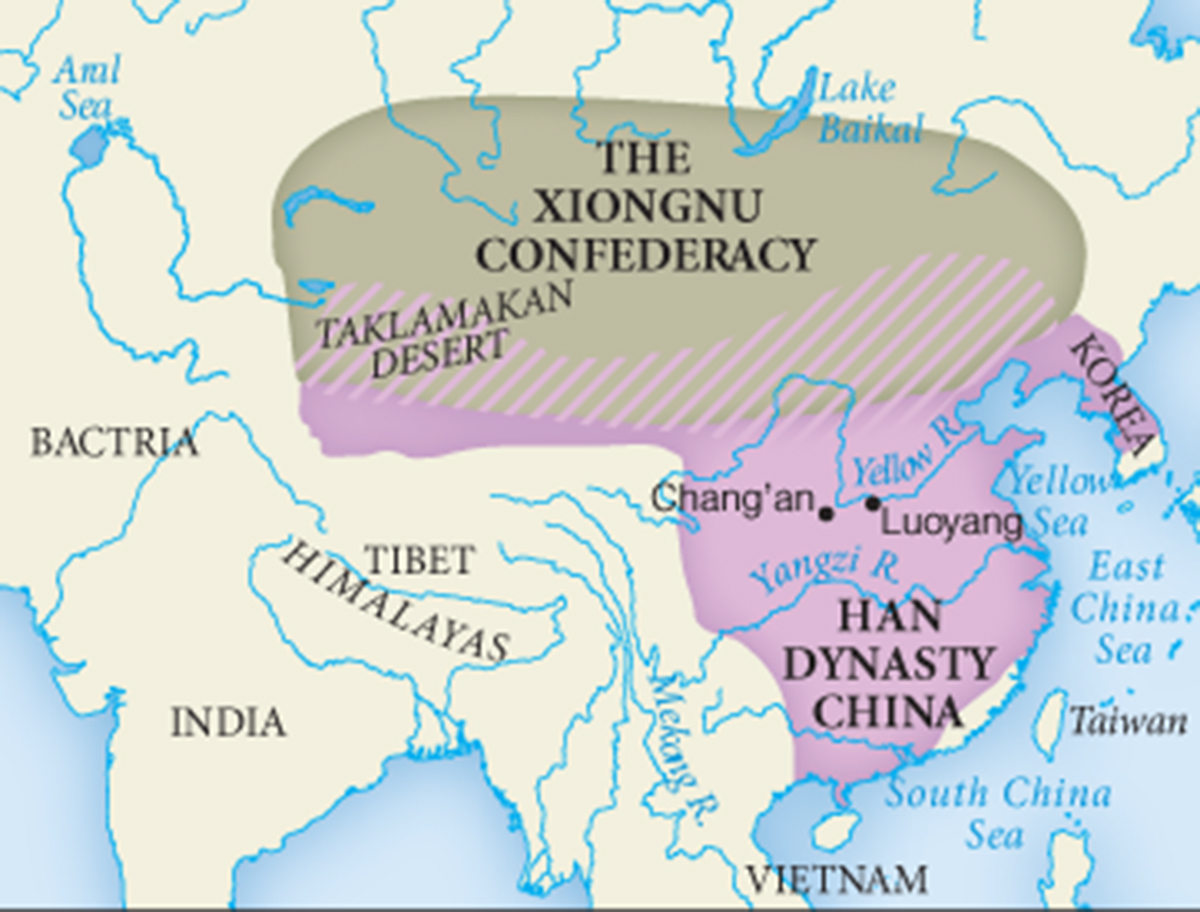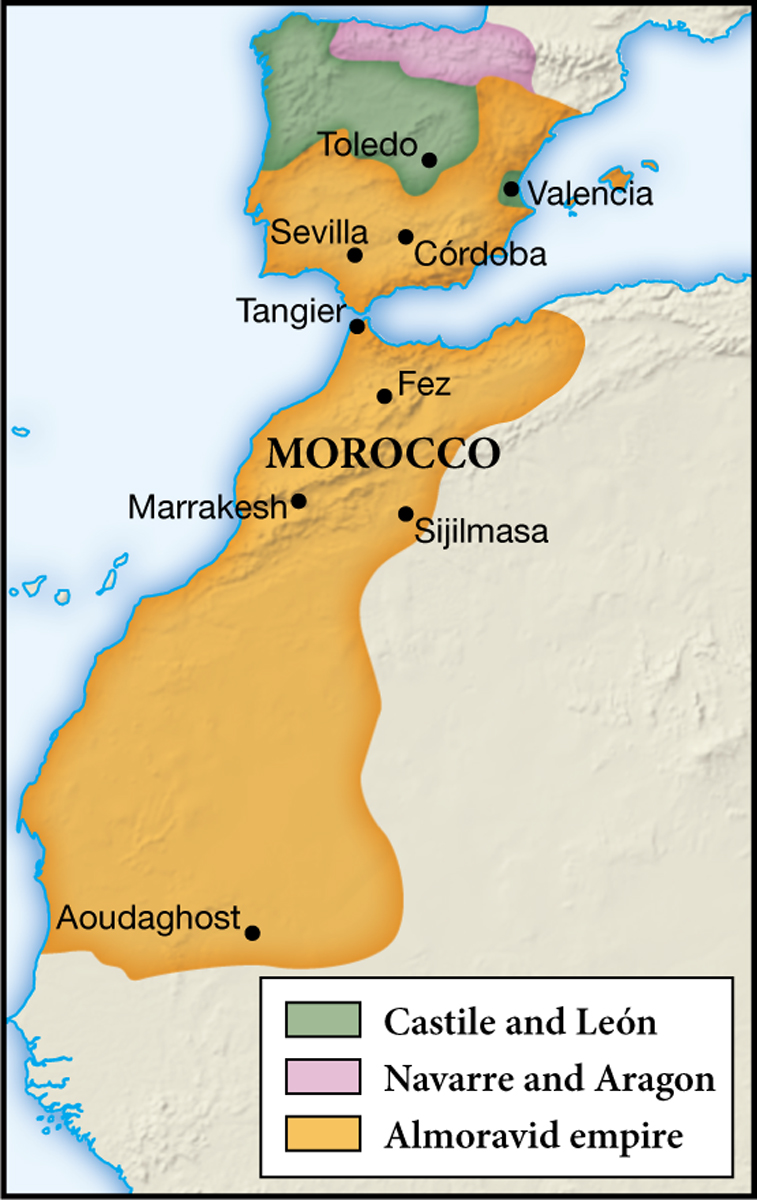Before the Mongols: Pastoralists in History

The Xiongnu Confederacy
What enabled pastoral peoples to make their most visible entry onto the stage of world history was the military potential of horseback riding, and of camel riding somewhat later. Their mastery of mounted warfare made possible a long but intermittent series of pastoral empires across the steppes of inner Eurasia and parts of Africa. For 2,000 years, those states played a major role in Afro-Eurasian history and represented a standing challenge to and influence upon the agrarian civilizations on their borders.
One early large-scale pastoral empire was associated with the people known as the Xiongnu, who lived in the Mongolian steppes north of China (see Chapter 8). Provoked by Chinese penetration of their territory, the Xiongnu in the third and second centuries B.C.E. created a huge military confederacy that stretched from Manchuria deep into Central Asia. Under the charismatic leadership of Modun (r. 210–174 B.C.E.), the Xiongnu Empire effected a revolution in pastoral life. Earlier fragmented and egalitarian societies were now transformed into a far more centralized and hierarchical political system in which power was concentrated in a divinely sanctioned ruler and differences between “junior” and “senior” clans became more prominent. “All the people who draw the bow have now become one family,” declared Modun. Tribute, exacted from other pastoral peoples and from China itself, sustained the Xiongnu Empire and forced the Han dynasty emperor Wen to acknowledge, unhappily, the equality of people he regarded as barbarians. “Our two great nations,” he declared, no doubt reluctantly, “the Han and the Xiongnu, stand side by side.”6
In what ways did the Xiongnu, Arabs, Turks, and Berbers make an impact on world history?
Although it subsequently disintegrated under sustained Chinese counterattacks, the Xiongnu Empire created a model that later Turkic and Mongol empires emulated. Even without a powerful state, various nomadic or semi-nomadic peoples played a role in the collapse of the already-weakened Chinese and Roman empires and in the subsequent rebuilding of those civilizations (see Chapter 3).
It was during the era of third-wave civilizations (500–1500) that pastoral peoples made their most significant mark on the larger canvas of world history. Arabs, Berbers, Turks, and Mongols—all of them of pastoral origin—created the largest and most influential empires of that millennium. The most expansive religious tradition of the era, Islam, derived from a largely pastoral people, the Arabs, and was carried to new regions by another pastoral people, the Turks. In that millennium, most of the great civilizations of outer Eurasia—Byzantium, Persia, India, and China—had come under the control of previously pastoral people, at least for a time. But as pastoralists entered and shaped the arena of world history, they too were transformed by the experience.
The first and most dramatic of these incursions came from Arabs. In the Arabian Peninsula, the development of a reliable camel saddle somewhere between 500 and 100 B.C.E. enabled pastoral Bedouin (desert-dwelling) Arabs to fight effectively from atop their enormous beasts. With this new military advantage, they came to control the rich trade routes in incense running through Arabia. Even more important, these camel pastoralists served as the shock troops of Islamic expansion, providing many of the new religion’s earliest followers and much of the military force that carved out the Arab Empire. Although intellectual and political leadership came from urban merchants and settled farming communities, the Arab Empire was in some respects a pastoralist creation that subsequently became the foundation of a new and distinctive civilization.

Seljuk Tiles Among the artistic achievements of Turkic Muslims were lovely ceramic tiles used to decorate mosques, minarets, palaces, and other public spaces. They contained intricate geometric designs, images of trees and birds, and inscriptions from the Quran. This one, dating from the thirteenth century, was used in a Seljuk palace, built as a summer residence for the sultan in the city of Konya in what is now central Turkey. (© Images & Stories/Alamy)
Even as the pastoral Arabs encroached on the world of Eurasian civilizations from the south, Turkic-speaking pastoralists were making inroads from the north. Never a single people, various Turkic-speaking clans and tribes migrated from their homeland in Mongolia and southern Siberia generally westward and entered the historical record as creators of a series of empires between 552 and 965 C.E., most of them lasting little more than a century. Like the Xiongnu Empire, they were fragile alliances of various tribes headed by a supreme ruler known as a kaghan, who was supported by a faithful corps of soldiers called “wolves,” for the wolf was the mythical ancestor of Turkic peoples. From their base in the steppes, these Turkic states confronted the great civilizations to their south—China, Persia, Byzantium—alternately raiding them, allying with them against common enemies, trading with them, and extorting tribute payments from them. Turkic language and culture spread widely over much of Inner Asia, and elements of that culture entered the agrarian civilizations. In the courts of northern China, for example, yogurt thinned with water, a drink derived from the Turks, replaced for a time the traditional beverage of tea, and at least one Chinese poet wrote joyfully about the delights of snowy evenings in a felt tent.7
A major turning point in the history of the Turks occurred with their conversion to Islam between the tenth and fourteenth centuries. This extended process represented a major expansion of the faith and launched the Turks into a new role as the third major carrier of Islam, following the Arabs and the Persians. It also brought the Turks into an increasingly important position within the heartland of an established Islamic civilization as they migrated southward into the Middle East. There they served first as slave soldiers within the Abbasid caliphate, and then, as the caliphate declined, they increasingly took political and military power themselves. In the Seljuk Turkic Empire of the eleventh and twelfth centuries, centered in Persia and present-day Iraq, Turkic rulers began to claim the Muslim title of sultan (ruler) rather than the Turkic kaghan. Although the Abbasid caliph remained the formal ruler, real power was exercised by Turkic sultans.

The Almoravid Empire
Not only did Turkic peoples become Muslims themselves, but they carried Islam to new areas as well. Their invasions of northern India solidly planted Islam in that ancient civilization. In Anatolia, formerly ruled by Christian Byzantium, they brought both Islam and a massive infusion of Turkic culture, language, and people, even as they created the Ottoman Empire, which by 1500 became one of the great powers of Eurasia (see Chapter 12, page 516). In both places, Turkic dynasties governed and would continue to do so well into the modern era. Thus Turkic people, many of them at least, had transformed themselves from pastoralists to sedentary farmers, from creators of steppe empires to rulers of agrarian civilizations, and from polytheistic worshippers of their ancestors and various gods to followers and carriers of a monotheistic Islam.
Broadly similar patterns prevailed in Africa as well. All across northern Africa and the Sahara, the introduction of the camel, probably during the first millennium B.C.E., gave rise to pastoral societies. Much like the Turkic-speaking pastoralists of Central Asia, many of these peoples later adopted Islam, but at least initially had little formal instruction in the religion. In the eleventh century C.E., a reform movement arose among the Sanhaja Berber pastoralists living in the western Sahara; they had only recently converted to Islam and were practicing it rather superficially. The movement was sparked by a scholar, Ibn Yasin, who returned from a pilgrimage to Mecca around 1039 seeking to purify the practice of the faith among his own people in line with orthodox principles. That religious movement soon became an expansive state, the Almoravid Empire, which incorporated a large part of northwestern Africa and in 1086 crossed into southern Spain, where it offered vigorous opposition to Christian efforts to conquer the region.
For a time, the Almoravid state enjoyed considerable prosperity, based on its control of much of the West African gold trade and the grain-producing Atlantic plains of Morocco. The Almoravids also brought to Morocco the sophisticated Islamic culture of southern Spain, still visible in the splendid architecture of the city of Marrakesh, for a time the capital of the Almoravid Empire. By the mid-twelfth century, that empire had been overrun by its longtime enemies, Berber farming people from the Atlas Mountains. But for roughly a century, the Almoravid movement represented an African pastoral people, who had converted to Islam, came into conflict with their agricultural neighbors, built a short-lived empire, and had a considerable impact on neighboring civilizations in both North Africa and Europe.


